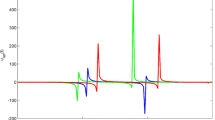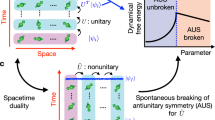Abstract
We present an algebraic framework to study the time-optimal synthesis of arbitrary unitaries in SU(2), when the control set is restricted to rotations around two non-parallel axes in the Bloch sphere. Our method bypasses commonly used control-theoretical techniques and easily imposes necessary conditions on time-optimal sequences. In a straightforward fashion, we prove that time-optimal sequences are solely parametrized by three rotation angles and derive general bounds on those angles as a function of the relative rotation speed of each control and the angle between the axes. Results are substantially different whether both clockwise and counterclockwise rotations about the given axes are allowed, or only clockwise rotations. In the first case, we prove that any finite time-optimal sequence is composed at most of five control concatenations, while for the more restrictive case, we present scaling laws on the maximum length of any finite time-optimal sequence. The bounds we find for both cases are stricter than previously published ones and severely constrain the structure of time-optimal sequences, allowing for an efficient numerical search of the time-optimal solution. Our results can be used to find the time-optimal evolution of qubit systems under the action of the considered control set and thus potentially increase the number of realizable unitaries before decoherence.






Similar content being viewed by others
Notes
The appearance of the region with \(\pi /2<\alpha <2\pi /3\) is not intuitive; since the marked zones only reflect necessary conditions for time-optimality, we independently confirm the existence of the two disjoint regions with numerical simulations.
During the preparation of this work, it was proven in [19] by a different method that finite sequences can be at most 4-long.
References
Khaneja, N., Brockett, R., Glaser, S.J.: Time optimal control in spin systems. Phys. Rev. A 63, 032308-1–032308-13 (2001)
Boozer, A.D.: Time-optimal synthesis of SU(2) transformations for a spin-1/2 system. Phys. Rev. A 85, 012317-1–012317-8 (2012)
Garon, A., Glaser, sj, Sugny, D.: Time-optimal control of SU(2) quantum operations. Phys. Rev. A 88, 043422-1–043422-12 (2013)
Boscain, U., Chitour, Y.: Time-optimal synthesis for left-invariant control systems on SO(3). SIAM J. Control Optim. 44, 111–139 (2005)
Boscain, U., Mason, P.: Time minimal trajectories for a spin 1/2 particle in a magnetic field. J. Math. Phys. 47, 062101-1–062101-29 (2006)
Boscain, U., Grönberg, F., Long, R., Rabitz, H.: Time minimal trajectories for two-level quantum systems with two bounded controls. arXiv:1211.0666v1, 42 pp. (2012)
Jelezko, F., Gaebel, T., Popa, I., Gruber, A., Wrachtrup, J.: Observation of coherent oscillations in a single electron spin. Phys. Rev. Lett. 92, 076401-1–076401-4 (2004)
Childress, L., Gurudev Dutt, M.V., Taylor, J.M., Zibrov, A.S., Jelezko, F., Wrachtrup, J., Hemmer, P.R., Lukin, M.D.: Coherent dynamics of coupled electron and nuclear spin qubits in diamond. Science 314, 281–285 (2006)
Hodges, J.S., Yang, J.C., Ramanathan, C., Cory, D.G.: Universal control of nuclear spins via anisotropic hyperfine interactions. Phys. Rev. A 78, 010303-1–010303-4 (2008)
Trelat, E.: Optimal control and applications to aerospace: some results and challenges. J. Optim. Theory Appl. 154, 713–758 (2012)
Pontryagin, L.S., Boltyanskii, V.G., Gamkrelidze, R.V., Mischenko, E.F.: The Mathematical Theory of Optimal Processes. Wiley, New York (1961)
Carlini, A., Hosoya, A., Koike, T., Okudaira, Y.: Time-optimal quantum evolution. Phys. Rev. Lett 96, 060503-1–060503-4 (2006)
Billig, Y.: Time-optimal decompositions in SU(2). Quantum Inf. Process 12, 955–971 (2013)
Jurdjevic, V., Sussmann, H.J.: Control systems on Lie groups. J. Differ. Equ. 12, 313–329 (1972). doi:10.1016/0022-0396(72)90035-6
Lowenthal, F.: Uniform finite generation of the rotation group. Rocky Mt. J. Math. 1, 575–586 (1971)
Piovan, G., Bullo, F.: On coordinate-free rotation decomposition: Euler angles about arbitrary axes. IEEE Trans. Robot. 28, 728–733 (2012)
Murray, R.M., Sastry, S.S., Zexiang, L.: A Mathematical Introduction to Robotic Manipulation, 1st edn. CRC Press Inc, Boca Raton (1994)
Agrachev, A.A., Gamkrelidze, R.V.: Symplectic geometry for optimal control. In: Sussman, H.J. (ed.) Nonlinear Controllability and Optimal Control, vol. 133, pp. 263–277. M. Dekker, New York (1990)
Billig, Y.: Optimal attitude control with two rotation axes. arXiv:1409.3102, 22 pp. (2014)
Khaneja, N.: Switched control of electron nuclear spin systems. Phys. Rev. A 76, 032326-1–032326-8 (2007)
Mitrikas, G., Sanakis, Y., Papavassiliou, G.: Ultrafast control of nuclear spins using only microwave pulses: towards switchable solid-state quantum gates. Phys. Rev. A 81, 020305-1–020305-4 (2010)
Morton, J.J.L., Tyryshkin, A.M., Brown, R.M., Shankar, S., Lovett, B.W., Ardavan, A., Schenkel, T., Haller, E.E., Ager, J.W., Lyon, S.A.: Solid-state quantum memory using the 31P nuclear spin. Nature 455, 1085–1088 (2008)
Morton, J.J.L., Tyryshkin, A.M., Ardavan, A., Benjamin, S.C., Porfyrakis, K., Lyon, S.A., Briggs, G.A.D.: Bang–bang control of fullerene qubits using ultrafast phase gates. Nat. Phys. 2, 40–43 (2006)
Assémat, E., Lapert, M., Zhang, Y., Braun, M., Glaser, S.J., Sugny, D.: Simultaneous time-optimal control of the inversion of two spin-1/2 particles. Phys. Rev. A 82, 013415-1–013415-6 (2010)
Aiello, C.D., Cappellaro, P.: Time-optimal control by a quantum actuator. Phys. Rev. A 91, 042340-1–042340-8 (2015)
Burgarth, D., Maruyama, K., Murphy, M., Montangero, S., Calarco, T., Nori, F., Plenio, M.B.: Scalable quantum computation via local control of only two qubits. Phys. Rev. A 81, 040303-1–040303-4 (2010)
Zhang, Y., Ryan, C.A., Laflamme, R., Baugh, J.: Coherent control of two nuclear spins using the anisotropic hyperfine interaction. Phys. Rev. Lett. 107, 170503-1–170503-5 (2011)
Acknowledgments
This work was supported in part by the US Air Force Office of Scientific Research through the Young Investigator Program. C.D.A acknowledges support from Schlumberger. The authors would like to thank Seth Lloyd for discussions; exchanges with Ugo Boscain and Domenico D’Alessandro are also gratefully acknowledged.
Author information
Authors and Affiliations
Corresponding author
Additional information
Michele Allegra and Börge Hemmerling have contributed equally to this work.
Rights and permissions
About this article
Cite this article
Aiello, C.D., Allegra, M., Hemmerling, B. et al. Algebraic synthesis of time-optimal unitaries in SU(2) with alternating controls. Quantum Inf Process 14, 3233–3256 (2015). https://doi.org/10.1007/s11128-015-1045-6
Received:
Accepted:
Published:
Issue Date:
DOI: https://doi.org/10.1007/s11128-015-1045-6




